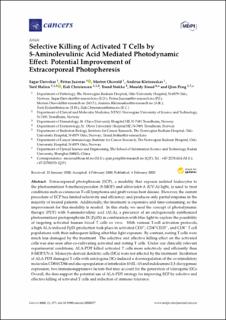| dc.description.abstract | Extracorporeal photopheresis (ECP), a modality that exposes isolated leukocytes to the photosensitizer 8-methoxypsoralen (8-MOP) and ultraviolet-A (UV-A) light, is used to treat conditions such as cutaneous T-cell lymphoma and graft-versus-host disease. However, the current procedure of ECP has limited selectivity and efficiency; and produces only partial response in the majority of treated patients. Additionally, the treatment is expensive and time-consuming, so the improvement for this modality is needed. In this study, we used the concept of photodynamic therapy (PDT) with 5-aminolevulinic acid (ALA), a precursor of an endogenously synthesized photosensitizer protoporphyrin IX (PpIX) in combination with blue light to explore the possibility of targeting activated human blood T cells ex vivo. With various T-cell activation protocols, a high ALA-induced PpIX production took place in activated CD3+, CD4+CD25+, and CD8+ T cell populations with their subsequent killing after blue light exposure. By contrast, resting T cells were much less damaged by the treatment. The selective and effective killing effect on the activated cells was also seen after co-cultivating activated and resting T cells. Under our clinically relevant experimental conditions, ALA-PDT killed activated T cells more selectively and efficiently than 8-MOP/UV-A. Monocyte-derived dendritic cells (DCs) were not affected by the treatment. Incubation of ALA-PDT damaged T cells with autologous DCs induced a downregulation of the co-stimulatory molecules CD80/CD86 and also upregulation of interleukin 10 (IL-10) and indoleamine 2,3-dioxygenase expression, two immunosuppressive factors that may account for the generation of tolerogenic DCs. Overall, the data support the potential use of ALA-PDT strategy for improving ECP by selective and effective killing of activated T cells and induction of immune tolerance. | en_US |

